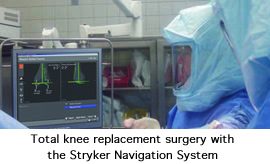Computer Assisted Surgery
A Giant Step Forward in Joint Replacement

If you're reading this website, chances are you (or a loved one) are considering or preparing for joint replacement surgery. You've likely tried several non-surgical therapies, including anti-inflammatory medication, injections into your joint and physical therapy. Still, pain and limited movement may hold you back from doing the things you used to do without worry.
And now there's even better news. Tremendous advances have been made in joint replacement that makes it a viable option for a greater number of people than ever before. Over the past four decades joint replacement has been proven to relieve severe joint pain and restore joint function in over 90% of patients undergoing the procedure.* As you read, make a note of anything you don't understand. Your doctor will be happy to answer your questions so that you'll feel comfortable and confident with your chosen treatment plan.
Leading Technology
During a joint replacement procedure, your surgeon will strive to ensure that everything is aligned properly. Accurate alignment of the hip or knee components is critical to the overall function of your new joint,1,2 and it also plays a role in helping your joint feel healthy again, and helping the joint replacement to potentially last longer.
Computer-assisted technology has made it possible for your orthopaedic specialist to navigate joint replacement procedures with a level of accuracy so precise it may improve the results of your surgery.1
What are some of the reasons orthopaedic surgeons choose computer-assisted technology?
- Provides your surgeon with comprehensive data about your anatomy which may result in more exact placement of your joint replacement
- Allows the surgeon to more accurately plan for your surgery with a partial 3-dimensional model of your hip or knee2
- Provides the surgeon with control, feedback and the ability to correct potential errors during the surgery1
- Allows for better visualization of anatomy, which is particularly important when minimally-invasive techniques are used

